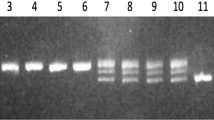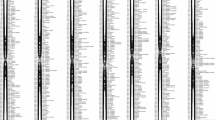Abstract
Fusarium wilt (FW), caused by the soil-borne fungal pathogen Fusarium oxysporum is a serious disease in cruciferous plants, including the radish (Raphanus sativus). To identify quantitative trait loci (QTL) or gene(s) conferring resistance to FW, we constructed a genetic map of R. sativus using an F2 mapping population derived by crossing the inbred lines ‘835’ (susceptible) and ‘B2’ (resistant). A total of 220 markers distributed in 9 linkage groups (LGs) were mapped in the Raphanus genome, covering a distance of 1,041.5 cM with an average distance between adjacent markers of 4.7 cM. Comparative analysis of the R. sativus genome with that of Arabidopsis thaliana and Brassica rapa revealed 21 and 22 conserved syntenic regions, respectively. QTL mapping detected a total of 8 loci conferring FW resistance that were distributed on 4 LGs, namely, 2, 3, 6, and 7 of the Raphanus genome. Of the detected QTL, 3 QTLs (2 on LG 3 and 1 on LG 7) were constitutively detected throughout the 2-year experiment. QTL analysis of LG 3, flanked by ACMP0609 and cnu_mBRPGM0085, showed a comparatively higher logarithm of the odds (LOD) value and percentage of phenotypic variation. Synteny analysis using the linked markers to this QTL showed homology to A. thaliana chromosome 3, which contains disease-resistance gene clusters, suggesting conservation of resistance genes between them.





Similar content being viewed by others
References
Armstrong GM, Armstrong JK (1952) Physiologic races of Fusaria causing wilts of the Cmciferae. Phytopathology 42:255–257
Bett KE, Lydiate DJ (2003) Genetic analysis and genome mapping in Raphanus. Genome 46:423–430
Bosland PW, Williams PH (1987) An evaluation of Fusarium oxysporum from crucifers based on pathogenicity, isozyme polymorphism, vegetative compatibility, and geographic origin. Can J Bot 65:2067–2073
Budahn H, Peterka H, Mousa MA, Ding Y, Zhang S, Li J (2009) Molecular mapping in oil radish (Raphanus sativus L.) and QTL analysis of resistance against beet cyst nematode (Heterodera schachtii). Theor Appl Genet 118:775–782
Diener AC, Ausubel FM (2005) RESISTANCE TO FUSARIUM OXYSPORUM 1, a dominant Arabidopsis disease-resistance gene, is not race specific. Genetics 171:305–321
Farnham MW, Keinath AP, Smith JP (2001) Characterization of fusarium yellows resistance in collard. Plant Dis 85:890–894
Garibaldi A, Gilardi G, Gullino ML (2006) Evidence for an expanded host range of Fusarium oxysporum f. sp. raphani. Phytoparasitica 34:115–121
Holub EB (1997) The gene-for-gene relationship in plant-parasite interactions. In: Crute IR et al (eds) Plant pathology. Wallingford, UK, pp 5–26
Kamei A, Tsuro M, Kubo N, Hayashi T, Wang N, Fujimura T, Hirai M (2010) QTL mapping of clubroot resistance in radish (Raphanus sativus L.). Theor Appl Genet 120:1021–1027
Kaneko Y, Kimizuka-Takagi C, Bang SW, Matsuzawa Y (2007) Radish. In: Kole C et al (eds) Genome mapping and molecular breeding in plants. Springer, New York, pp 141–160
Kendrick JB, Snyder WC (1942) Fusarium wilt of radish. Phytopathology 32:1031–1033
Kim H, Choi SR, Bae J, Hong CP, Lee SY, Hossain MJ, Van Nguyen D, Jin M, Park BS, Bang JW, Bancroft I, Lim YP (2009) Sequenced BAC anchored reference genetic map that reconciles the ten individual chromosomes of Brassica rapa. BMC Genomics 10:432
Koch MA, Haubold B, Mitchell-Olds T (2000) Comparative evolutionary analysis of chalcone synthase and alcohol dehydrogenase loci in Arabidopsis, Arabis, and related genera (Brassicaceae). Mol Biol Evol 17:1483–1498
Lagercrantz U (1998) Comparative mapping between Arabidopsis thaliana and Brassica nigra indicates that Brassica genomes have evolved through extensive genome replication accompanied by chromosome fusions and frequent rearrangements. Genetics 150:1217–1228
Li XN, Ramchiary N, Choi SR, Nguyen DV, Hossain MJ, Yang HK, Lim YP (2010) Development of a high density integrated reference genetic linkage map for the multinational Brassica rapa genome sequencing project. Genome 53:939–947
Li F, Hasegawa Y, Saito M, Shirasawa S, Fukushima A, Ito T, Fujii H, Kishitani S, Kitashiba H, Nishio T (2011) Extensive chromosome homoeology among Brassiceae species were revealed by comparative genetic mapping with high-density EST-based SNP markers in radish (Raphanus sativus L.). DNA Res 18:401–411
Li XN, Ramchiary N, Dhandapani V, Choi SR, Hur YK, Yoon MK, Lim YP (2013) Quantitative trait loci mapping in Brassica rapa revealed the structural and functional conservation of genetic loci governing morphological and yield component traits in the A, B, and C subgenomes of Brassica species. DNA Res 20:1–16
Lysak MA, Koch MA, Pecinka A, Schubert I (2005) Chromosome triplication found across the tribe Brassiceae. Genome Res 15:516–525
Mayer K, Schuller C, Wambutt R, Murphy G, Volkaert G, Pohl T, Dusterhoft A, Stickema W, Entian K-D, Terryn N (1999) Sequence and analysis of chromosome 4 of the plant Arabidopsis thaliana. Nature 402:769–777
Meyerowitz E (1992) Introduction to the Arabidopsis genome. In: Koncz C, Chua N, Schell J (eds) Methods in Arabidopsis research. World Scientific, Singapore, pp 102–118
Mun JH, Kwon SJ, Yang TJ, Kim HS, Choi BS, Baek SH, Kim JS, Jin M, Kim JA, Lim MH, Lee SI, Kim HI, Kim HT, Lim YP, Park BS (2008) The first generation of a BAC-based physical map of Brassica rapa. BMC Genomics 9:280
Murray MG, Thompson WF (1980) Rapid isolation of high molecular weight plant DNA. Nuc Acids Res 8:4321–4325
O’Neill CM, Bancroft I (2000) Comparative physical mapping of segments of the genome of Brassica oleracea var. alboglabra that are homoeologous to sequenced regions of chromosomes 4 and 5 of Arabidopsis thaliana. Plant J 23:233–243
Panjabi P, Jagannath A, Bisht NC, Padmaja KL, Sharma S, Gupta V, Pradhan AK, Pental D (2008) Comparative mapping of Brassica juncea and Arabidopsis thaliana using intron polymorphism (IP) markers: homoeologous relationships, diversification and evolution of the A, B and C Brassica genomes. BMC Genomics 9:113
Parkin IAP, Gulden SM, Sharpe AG, Lukens L, Trick M, Osborn TC, Lydiate DJ (2005) Segmental structure of the Brassica napus genome based on comparative analysis with Arabidopsis thaliana. Genetics 171:765–781
Pu ZJ, Shimizu M, Zhang YJ, Nagaoka T, Hayashi T, Hori H, Matsumoto S, Fujimoto R, Okazaki K (2011) Genetic mapping of a fusarium wilt resistance gene in Brassica oleracea. Mol Breed 30(2):809–818
Ramchiary N, Nguyen DV, Li XN, Hong CP, Dhandapani V, Choi SR, Ge Y, Piao ZY, Lim YP (2011) Genic microsatellite markers in Brassica rapa: development, characterisation, mapping, and their utility in other cultivated and wild Brassica relatives. DNA Res 18:305–320
Schranz ME, Lysak MA, Mitchell-Olds T (2006) The ABC’s of comparative genomics in the Brassicaceae: building blocks of crucifer genomes. Trends Plant Sci 11:535–542
Shirasawa K, Oyama M, Hirakawa H, Sato S, Tabata S, Fujioka T, Kimizuka-Takagi C, Sasamoto S, Watanabe A, Kato M, Kishida Y, Kohara M, Takahashi C, Tsuruoka H, Wada T, Sakai T, Isobe S (2011) An EST-SSR linkage map of Raphanus sativus and comparative genomics of the Brassicaceae. DNA Res 18:221–232
Smith SN, Ebbels DL, Garber RH, Kappelman AJ (1981) Fusarium wilt of cotton. In: Nelson PE, Toussoun TA, Cook RJ (eds) Fusarium: diseases, biology, and taxonomy. Pennsylvania State University, University Park, pp 29–38
Suwabe K, Tsukazaki H, Iketani H, Hatakeyama K, Kondo M, Fujimura M, Nunome T, Fukuoka H, Hirai M, Matsumoto S (2006) Simple sequence repeat-based comparative genomics between Brassica rapa and Arabidopsis thaliana: the genetic origin of clubroot resistance. Genet 173:309–319
Tsuro M, Suwabe K, Kubo N, Matsumoto S, Hirai M (2005) Construction of a linkage map of radish (Raphanus sativus L.), based on AFLP and Brassica-SSR markers. Breed Sci 55:107–111
Tsuro M, Suwabe K, Kubo N, Matsumoto S, Hirai M (2008) Mapping of QTLs controlling for root shape and red pigmentation in radish, Raphanus sativus L. Breed Sci 58:55–61
Van Ooijen JW (2006) JoinMap 4.0. Software for the calculation of genetic linkage maps in experimental populations. Kyazma BV, Wageningen
Wang S, Basten CJ, Zeng ZB (2006) Windows QTL Cartographer V2.5. User manual Bioinformatics Research Centre, North Carolina State University, Raleigh
Wang X, Wang H, Wang J, Sun R, Wu J et al (2011) The genome of the mesopolyploid crop species Brassica rapa. Nat Genet 43:1035–1039
Warwick SI, Black LD (1991) Molecular systematics of Brassica and allied genera (subtribe Brassicinae, Brassiceae)—chloroplast genome and cytodeme congruence. Theor Appl Genet 82:81–92
Xu L, Wang L, Gong Y, Dai W, Wang Y, Zhu X, Wen T, Liu L (2012) Genetic linkage map construction and QTL mapping of cadmium accumulation in radish (Raphanus sativus L.). Theor Appl Genet 125:659–670
Yang YW, Lai KN, Tai PY, Li WH (1999) Rates of nucleotide substitution in angiosperm mitochondrial DNA sequences and dates of divergence between Brassica and other angiosperm lineages. J Mol Evol 48:597–604
Young ND (2000) The genetic architecture of resistance. Curr Opin Plant Biol 3:285–290
Zeng ZB (1994) Precision mapping of quantitative trait loci. Genetics 136:1457–1468
Acknowledgments
This work was supported by a grant from the Next-Generation BioGreen 21 Program (Plant Molecular Breeding Center No. PJ007992), Rural Development Administration, Republic of Korea.
Author information
Authors and Affiliations
Corresponding author
Additional information
Communicated by M. J. Havey.
X. Yu and S. R. Choi contributed equally to this work.
Electronic supplementary material
Below is the link to the electronic supplementary material.
Rights and permissions
About this article
Cite this article
Yu, X., Choi, S.R., Ramchiary, N. et al. Comparative mapping of Raphanus sativus genome using Brassica markers and quantitative trait loci analysis for the Fusarium wilt resistance trait. Theor Appl Genet 126, 2553–2562 (2013). https://doi.org/10.1007/s00122-013-2154-1
Received:
Accepted:
Published:
Issue Date:
DOI: https://doi.org/10.1007/s00122-013-2154-1




